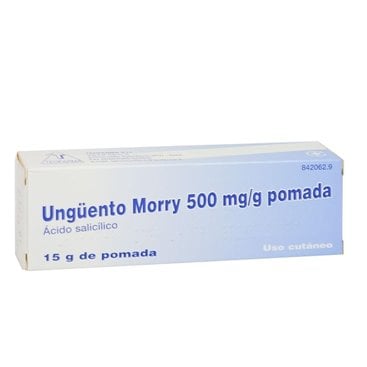Morry Ointment 500 Mg/G 15 G
Morry's ointment is a medicine that contains the active substance salicylic acid. Salicylic acid has keratolytic action (dissolves skin keratin) allowing the removal of calluses, crow's eyes, corns and common warts, when applied to the skin. This medicine is used in the treatment of corns and calluses as well as common warts in adults and adolescents over 12 years of age.
Morry's ointment is a medicine that contains the active substance salicylic acid. Salicylic acid has keratolytic action (dissolves skin keratin) allowing the removal of calluses, crow's eyes, corns and common warts, when applied to the skin. This medicine is used in the treatment of corns and calluses as well as common warts in adults and adolescents over 12 years of age.
Morry ointment (500 Mg/G 1 Tube 15 G)
Salicylic acid
ACTION AND MECHANISM
- Keratolytic. Salicylic acid presents a keratolytic activity at concentrations between 2-6%, becoming caustic at concentrations higher than 20%. Its application on hyperkeratotic areas of the skin causes a softening of the epidermal horny tissue by dissolution of the keratin intercellular cement, probably due to an increase in the local concentration of water due to the decrease in dermal pH.
This results in desquamation of the hyperkeratotic epithelium, especially in a humid environment to favor maceration, without affecting the viable epidermal structures.
At low concentrations (<1%), salicylic acid acts on the contrary as a keratoplastic, favoring proper epidermal keratinization.
PHARMACOKINETICS
- Absorption: limited absorption in case of correct application. Some absorption may occur when applying to healthy skin, especially in case of occlusion. The cmax (0.3-0.9 mcg/ml) is reached 5 h after its application and subsequent occlusion.
- Distribution: 50-80% is bound to plasmatic proteins, mainly albumin. The Vd is 0.17 l/kg.
- Metabolism: salicylic acid is partially metabolized. The metabolites generated depend on the route of administration. Thus, after its topical application, glucuronated derivatives predominate (42%), compared to salicyluric acid (glycine-conjugated salicylic acid), which is predominant when applied orally.
- Elimination: in urine (95%), with a t1/2 of 2-3 h. With high doses, t1/2 can rise to 15-30 h due to saturation of hepatic metabolism.
INDICATIONS
- [CALLUSES].
- [WARTS].
POSOLOGY
"MORRY OINTMENT"
- Adults and adolescents > 12 years: apply a layer on the affected area 2 times a day, when getting up and when going to bed.
- Children < 12 years: use only under medical recommendation, due to the possible greater systemic absorption.
Duration of treatment: calluses usually fall off after 3-6 days of treatment, and their fall can be helped by washing the area with hot water. If after 4-6 days no effect is appreciated, the treatment will be suspended and the doctor and/or pharmacist will be consulted.
DOSAGE IN RENAL FAILURE
No specific dosage recommendations have been made.
DOSAGE IN LIVER FAILURE
No specific dosage recommendations have been made.
RULES FOR CORRECT ADMINISTRATION
Before administration, adequately wash the area with soap and water, and dry.
- Ointment: to avoid damage to the surrounding healthy area, it is recommended to surround said area with Vaseline, and apply only salicylic acid to the affected area. After application, cover the affected area with gauze or a band-aid. Wash hands with soap and water after each application.
CONTRAINDICATIONS
- [ALLERGY TO SALICYLATES] or to any other component of the medication.
- People with peripheral circulatory problems or [DIABETES].
PRECAUTIONS
- Do not apply on the face, neck or genitals, as well as on moles or skin areas with irritative, inflammatory processes or wounds. Avoid contact with eyes, mucous membranes or areas of healthy skin.
ADVICE TO THE PATIENT
Administration rules:
- Do not apply on the face, neck, genitals or areas of healthy skin, with moles or with inflammation or wounds.
- Wash the area with hot water and soap before administration. Dry well.
- Ointment: protect the area surrounding the callus with Vaseline, and apply a thin layer on the callus. Cover with gauze or bandage and wash hands.
INTERACTIONS
- Keratolytics. Avoid co-administration with other keratolytic or exfoliating drugs, such as azelaic acid, adapalene, benzoyl peroxide, or isotretinoin, as dermal ulceration could occur.
PREGNANCY
Safety in animals: no data available.
Safety in humans: There are no adequate and well-controlled studies in humans. It can be systematically absorbed, so its use is not recommended.
Effects on Fertility: No specific studies have been conducted in humans.
LACTATION
Safety in animals: no data available.
Safety in humans: it is unknown if it is excreted in milk, and the consequences it could have for the nursing infant. Its administration during lactation is not recommended.
CHILDREN
In children under 12 years of age, greater systemic absorption may occur after topical administration, so it will only be used under medical recommendation, and after assessing its benefits and risks.
ADVANCED AGE
No specific problems have been described in the elderly that require a dose readjustment.
EFFECTS ON DRIVING
It is not estimated that it can negatively affect the ability to drive.
ADVERSE REACTIONS
Adverse reactions are described according to each frequency interval, being considered very common (>10%), common (1-10%), uncommon (0.1-1%), rare (0.01-0.1%). , very rare (<0.01%) or frequency unknown (cannot be estimated from the available data).
- Dermatological: in case of application on areas of healthy skin, [CUTANEOUS IRRITATION], [DERMATITIS] and even [CUTANEOUS ULCERA] could occur.
- Allergic: frequent [HYPERSENSITIVITY REACTIONS].
OVERDOSE
Symptoms: due to its route of administration, it is unlikely that a significant overdose can occur. In case of excessive application, especially on areas of healthy skin, skin irritation could occur.
Contact with the eyes can cause significant irritation and in the most severe cases could lead to corneal ulceration.
Treatment: symptomatic, through the administration of emollients. In case of contact with the eyes or mucous membranes, wash abundantly with water.



